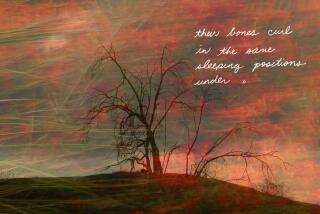Natural Selection
Surrounded by the Coconino National Forest in Arizona, a mountain of cinders called Sunset Crater rears above the pinon pines much as it must have done after the decades of eruption that started in 1064. The red tint at its summit could almost be the rocks still glowing. On either side of the smooth black road, the scrubland is eerily perfect and unbroken. The earth, the rocks, the plant life are beautifully themselves: “Unspoiled” is the word we use for these shrinking zones of the Earth. No grazing, mining or building is happening here. No fence posts, no advertisements, no flapping shreds of indestructible plastic disfigure this place. After the scruffiness of the land outside the forest, it is like stepping back into Eden before the Fall--that is, nature before the human race.
For the last 250 years, our writers have constantly visited such tracts of nature to refresh themselves, to understand the cosmos more fully and sometimes to see themselves reflected in the mirror of the great lakes and little ponds, the broad rivers and high snowfields. Once, before the Renaissance, nature was seen by artists more as a frame or stylized setting than as a thing in itself. No writer in English before Shakespeare seemed to be able to tell one flower from another, or at least considered it significant. A beetling crag or two, some leafy branches, even a rainbow might just be visible round the edges of a picture whose subject and center was the adoration of the virgin and child or the passion of a sainted martyr.
As telescope and microscope showed us nature in ever-sharper focus and travelers brought back less fanciful and more realistic accounts of the great wildernesses, writers became more and more enthralled by nature in all its teeming particulars. Explorers such as Meriwether Lewis and William Clark published sober records of what they had seen, for example at the headwaters of the Missouri between 1804 and 1806. The more visionary writers found in nature an unlimited confirmation of the majesty of the created world. This could run to self-conscious and rather sermonizing rhetoric, as in Emerson, or to inspirational images of glaciated mountains with their waterfalls and flowery meadows, as in John Muir.
The entire gamut of such writing is sampled with wonderful thoroughness and intelligence in Robert Finch and John Elder’s huge anthology. As we journey through it and come near to the present, a keener and keener lament arises, in the voices of Edward Abbey and Wendell Berry, Gary Snyder and Wallace Stegner and Thomas Merton. Their simple burden is: See how we are trashing Paradise. We are reminded once again that our best writers find it hard to celebrate the health and comfort of modern civilization. They love the species, all of them (even the scorpions and the lice?), and they are anguished by the tendency of our own species to wipe out even what we enjoy or admire, for example the tiger and the cod.
The chief glory of the anthology lies in its evocation of the natural life which still swarms around us in spite of the clearing of the forests and the fouling of the rivers. A peregrine falcon flies across Essex, England: “Pouring away behind the moving bird, the land flows out from the eye in deltas of piercing color.” Hellebores flower in Tuscany, Italy, with “a peculiar wintry quality of invisibility, so lonely rising from the sere grass, and pallid green, held up like a little hand-mirror that reflects nothing.” Water ouzels in Yosemite National Park “swoop down the inclines of cascades, dropping sheer over dizzy falls amid the spray ... the streams tracing the ancient glaciers, the ouzels tracing the streams.” Elephants wallow in a swamp in Tanzania: “Even at rest the herd flowed in perpetual motion, the ears like delicate great petals, the ripple of the mud-caked flanks, the coiling trunks--a dream rhythm, a rhythm of winds and trees.”
Even the dumbfounding silence of the universe beyond Earth’s atmosphere turns into a marvelous vision as writer Chet Raymo broods after an accident on Boston Common: “The Milky Way flows across the dark shoals of the summer sky without an audible ripple.... The universe fattens and swells in a Big Bang, a fireball of Creation exploding from a pinprick of infinite energy, the ultimate firecracker; there is no soundtrack. The membrane is ruptured, a child flies through the air, and the universe is silent.”
Reading this book is like a trek through the whole accessible world back and forth in time: from the lagoons of Florida swarming with trout and roaring alligators (in 1791), to the Columbia River in the Northwest where silver coho salmon leap (in 1968) from polluted water that coats the shore “with what looked like dead human skin for miles”; from the street in Puerto Limon, Costa Rica, where nine three-toed sloths brachiate in slow motion along the power cables, to the caves in Bali where spiders test the tautness of their webs by dancing on the new-spun strands a few inches away from gushing monsoon torrents. Read this book with an atlas at your elbow, and you are drawn into the beautiful crannies and the exposed harsh uplifts of the Earth, from the little valleys in Sussex, England, where a clergyman (in 1770) shouts out lines of Latin poetry to test the distinctness of an echo, to the Eagle Tail Mountains of western Arizona, in which a grindstone sits on the floor of a cave where it may well have rested for 800 years.
Because nearly all of these 133 writers are fine observers, they take us most intimately into the bays and cliffs and meadows where life flourishes in its dizzy variety. Because they are used to spending hours and days and weeks in intent, often solitary contemplation, they are expert at teasing out the implications of what they see and touch. These concern the relationships of our species to the other species, and because we have so often cruelly harnessed them, imprisoned them and slaughtered them and wiped them out, the upshot is often painful. We injure and deform our own natures as much as we damage the nature that is “out there.”
Perhaps the most important single revelation of the book is that not everyone’s experience of nature is the same, that a person of color’s experience, for instance, may well be quite different from a white person’s. Alice Walker describes the changing look in the eyes of a horse, called Blue, which is briefly allowed a mate to share his meadow, then sees her taken away again when she has duly become pregnant. Walker gives him an apple; he half-crunches it, then lets it fall: “I dreaded looking into his eyes ... but I did look. If I had been born into slavery, and my partner had been sold or killed, my eyes would have looked like that.” So an experience of nature for an African American woman can’t help being deformed by historic cruelties.
This is most strikingly discussed in Evelyn White’s “Black Women and the Wilderness.” For me, for many of us, the wilderness is delightful. It troubles me only when a rock-hold breaks off in my hand or a blizzard covers my footprints and the way back home becomes uncertain. White was brought up in Indiana. When she was 9, she was terrified by the 1963 bombing that killed four black girls in Sixteenth Street Baptist Church in Birmingham, Ala. In her house were copies of JET magazine with photos of Emmett Till, the Chicago teenager who was battered and hanged in Mississippi for allegedly whistling at a white woman. As she grew up, she became “speechless and paralyzed with heart-stopping fear” whenever she crossed paths with tough white loggers or went out into the countryside: “I imagined myself being captured in a swampy backwater” by white-robed klansmen with bloodhounds. She became reconnected with “the comfort my ancestors felt in the rift valleys of Kenya and on the shores of Sierra Leone” only when she went rafting with a friend and was swept downriver, enchanted by the rapids and the tall trees and repeating to herself a rhapsody by Langston Hughes on the rivers of the tropics.
Nature is even less innocent for people who have been enslaved than for those of us who have been privileged by a comfortable life, enabled to treat nature as a sort of Elysium in which we can holiday and lose ourselves--as it is often called--although what this anthology expresses again and again is the enhanced sense of self that people can experience when they hear a crane calling above the Wisconsin marshland or “listen” to the silence in the Escalante Canyon north of Lake Powell in Utah or help a starving lioness die among the grasses in the Serengeti.
Those examples come from Africa and from what Meridel Lesueur calls “the guerrilla soil of the Americas.” It is natural that Finch and Elder should favor terrain where the life of wild creatures is most striking, the raptors and carnivores most handsomely toothed and winged, the floods and lightning most spectacular. It is a shame that their sense of “The Tradition in English” excludes all non-American writers born since 1940 and that the last quarter of their anthology has nothing from any book originating in the United Kingdom since 1979. This imbalance excludes, for example, Jim Crumley, the best nature writer now working in Great Britain, who has produced extraordinary evocations of the Cairngorm Mountains of Scotland where the flight of ptarmigan defines the great hollows of the corries and the cry of wild geese flying at 6,500 feet is the only sound in the Great Moss, the Moine Mhor. It excludes Richard Dawkins, Oxford professor of public understanding of science, whose work on animal behavior and on “the selfish gene” has brought us closer to the core of human nature than any other writer. Canada is well enough represented, Australia and New Zealand scarcely at all. The work of American pioneers such as William Bartram and Lewis should surely have been balanced by the best early Australians, especially Ernest Giles, who evoked in piercing detail the impact of the Red Center on the first white men to set foot in it. African writing is represented by Isak Dinesen and Laurens van der Post. Was it high permission fees, which the editors mention in their introduction, that prevented them from using Doris Lessing’s rich descriptions in “African Laughter” of her childhood among the bush animals in what was then Rhodesia?
Some valuable things are missing from “Nature Writing.” What is included is almost wholly excellent. The book feels as abundant as the nature it reflects. Of course it isn’t: Nature will always exceed our perceptions and our language. We aspire to express it all and the energies we devote to this are what gives “Nature Writing” its pulsating vitality.
*
From ‘Nature Writing’
“It is interesting to contemplate a tangled bank, clothed with many plants of many kinds, with birds singing on the bushes, with various insects flitting about, and with worms crawling through the damp earth, and to reflect that these elaborately constructed forms, so different from each other and dependent upon each other in so complex a manner, have all been produced by laws acting around us.”
--Charles Darwin, “On the Origin of Species”
*
David Craig is the author of a trilogy of outdoor books, “Native Stones,” “On the Crofters’ Trail” and “Landmarks.”


